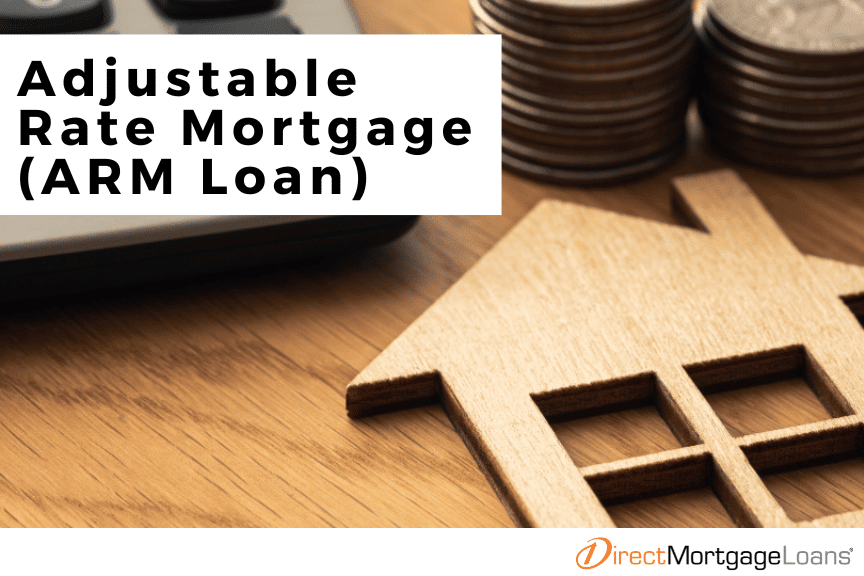Adjustable Rate Mortgage (ARM) Loan
What is an Adjustable Rate Mortgage (ARM)?
An Adjustable Rate Mortgage (ARM Loan) is a type of home loan that comes with a variable interest rate. This means that the amount of money you pay towards your mortgage each month may change depending on how the interest rate changes. Unlike a fixed-rate mortgage that maintains the same interest rate for the entire loan term, the interest rate of an ARM loan can go up or down based on market conditions.
The key benefit of an ARM loan is that it usually has a lower initial interest rate, which could make it more affordable for homebuyers in the early stages of the loan. However, it is important to note that interest rates are not guaranteed to stay low. After the initial lower interest rate period, your interest rate will fluctuate, which could result in higher monthly payments down the line.
Adjustable Rate vs Fixed Rate Mortgage
The two main types of mortgages are fixed rate and adjustable rate (ARM). A fixed rate mortgage could begin with a higher initial rate compared to an ARM, but the interest rate on a fixed rate mortgage remains constant throughout the entire loan period. It’s ideal for those seeking predictability and intending to stay in their home for the long term.
On the other hand, an adjustable rate mortgage (ARM) begins with a lower interest rate for a set period (e.g., 3, 5, or 7 years). After the agreed upon time, the rate could change based on market conditions. This may result in fluctuations in monthly payments. Nonetheless, ARMs are attractive for budget conscious individuals but are better suited for those comfortable with potential payment adjustments and with shorter term housing plans.
How does an adjustable rate mortgage work?
An adjustable rate mortgage (ARM) is a type of mortgage that has a fixed interest rate for an initial period, usually between 3 and 10 years. During this time, the interest rate remains the same, which is usually lower than a fixed rate mortgage. However, after the fixed period ends, the interest rate may start to adjust based on the market index. This means that if interest rates increase, your rate and monthly payments could also increase. Conversely, if interest rates decrease, your rate and payments could also decrease.
ARMs could be a good option for individuals who plan to sell their house before the fixed period ends, or those who are comfortable with the possibility of interest rate changes. It is important to carefully consider your financial situation, goals, and risk tolerance before deciding if an ARM is right for you.
What are the 4 components of an arm loan?
An ARM loan has four components: an index, a margin, an interest rate cap structure (adjustment period), and an initial interest rate period. Let’s explore in more detail what each of these components entails.
Initial Interest Rate
When you finalize your home purchase with an ARM, you’ll secure a fixed interest rate and a corresponding monthly payment for a set introductory period. This initial period typically ranges from 3 to 10 years, depending on the specific ARM product you choose.
Index
This serves as a benchmark which reflects interest rates within the broader economy. The index, often based on a financial indicator like the treasury index, is used to calculate the change of your ARM’s interest rate adjustment after the initial fixed-rate period.
Margin
Think of the margin as the lender’s built-in profit added to your interest rate. The margin is a fixed percentage that gets added to the index rate after the initial period to determine your new adjusted interest rate.
Adjustment Period
This refers to the frequency at which your ARM’s interest rate and monthly payment can change. These adjustments can occur monthly, quarterly, yearly, or even less frequently, depending on the specific ARM. For example, a 5/1 ARM would have a fixed rate for the first 5 years (the initial period), followed by adjustments every year (the adjustment period).
Refinancing An ARM Loan
Yes, it is possible to refinance an ARM loan. Refinancing an ARM loan involves replacing your current ARM with a new mortgage loan. This can be done for different reasons, such as securing a lower interest rate, shortening the loan term, or switching to a different type of mortgage loan.
Types of ARM Loans
ARM loans are typically described using a two-part numbering system. The first number represents the initial period when the interest rate remains fixed. The second number indicates the frequency of adjustments after the fixed-rate period ends. Here’s a breakdown of common ARM options:
5/1 and 5/6 ARM
These ARM loans provide a fixed interest rate for the initial 5 years. The second number indicates how often the rate adjusts after the first 5 years. In a 5/1 ARM, the rate adjusts yearly, while a 5/6 ARM adjusts every 6 months.
7/1 and 7/6 ARM
These ARMs offer a fixed rate for the initial 7 years, followed by 23 years of fluctuating payments based on changing interest rates. Remember, your mortgage payment may increase or decrease depending on interest rate fluctuations
10/1 and 10/6 ARMs
With a fixed rate for the first 10 years, 10/1 and 10/6 ARMs involve changing payments for the remaining 20 years. The interest rate will vary based on market conditions, influencing your monthly mortgage payments.
What is an advantage of an adjustable rate mortgage?
An adjustable rate mortgage offers several key benefits that make them an attractive option.
- Lower Introductory Interest Rate: ARMs typically offer lower introductory interest rates than fixed-rate mortgages, which could save you money on your monthly payments during the initial period of the loan.
- Flexibility: ARMs can offer more flexibility than fixed-rate mortgages. For example, some ARMs allow you to skip payments or convert to a fixed-rate mortgage during the introductory period.
- Potential for Lower Interest Rates Over Time: If interest rates decline, your ARM’s interest rate could also decline, which could save you money on your monthly payments over the long term.
What are the negatives to an adjustable rate mortgage?
Despite the benefits of adjustable rate mortgages (ARMs), there are some potential drawbacks that you should be aware of.
- Interest Rate Fluctuations: The biggest concern with ARMs is the risk of rising interest rates. If rates go up, your ARM’s interest rate will adjust as well, potentially causing a significant increase in your monthly payment.
- Budgeting Challenges: The uncertainty of how your interest rate will change could make it difficult to plan your budget for future monthly mortgage payments.
Are adjustable mortgage rates a good idea?
Whether an adjustable rate mortgage (ARM) is a good fit for you depends on your financial goals and timeline. ARMs could be a good option if you plan to sell or refinance your home within the initial fixed-rate period, which typically lasts a few years. This allows you to take advantage of a lower introductory interest rate, potentially saving money on your monthly payments during the early years of your loan.
ARMs might also be an option worth considering if you expect your income to increase in the future. The lower initial rate could provide some breathing room in your budget early on. As your income grows, you could be in a better position to handle any potential interest rate adjustments down the line.
However, ARMs come with inherent uncertainty. The interest rate, and consequently your monthly payment, could fluctuate based on market conditions. If you’re comfortable with this unpredictability and have a plan to manage potential increases, then an ARM could be a suitable option.
Ultimately, ARMs are a good fit for borrowers who prioritize a lower initial interest rate and are open to the possibility of higher monthly payments in the future. The attractive starting rate can give you a financial advantage when you first purchase your home. However, it’s important to carefully consider your long-term financial goals and speak with a loan officer before deciding if this option is the right choice for you.
How can I find ARM lenders near me?
Direct Mortgage Loans provides a variety of mortgage options including Adjustable Rate Mortgages. Contact one of our expert Loan Officers to learn more.
Adjustable Rate Mortgage FAQ’s
What is the adjustable mortgage rate today?
To determine your current adjustable mortgage rate, lenders consider factors such as your credit score, down payment, and debt-to-income ratio. For a personalized analysis and rate quote, reach out to one of our Loan Officers. They’ll provide expert guidance tailored to your unique financial situation.
Does the VA do ARM loans?
VA loans are available in both fixed-rate and adjustable-rate mortgages. Typically, ARMs usually have a low introductory interest rate for a few years and then change annually based on the market. Although an ARM may save money initially, the interest rate may increase later. If you are considering a VA ARM, it is best to speak with a Loan Officer who could help you determine which option is right for you.
Do ARM mortgages require 20% down?
ARM mortgages do not always require a 20% down payment. For instance, a conventional ARM could require a minimum of 5% down payment, while an FHA ARM may require at least 3.5%. However, if you put down less than 20%, you will have to pay mortgage insurance with both conventional and FHA loan types. On the other hand, VA ARMs do not have a down payment requirement.
Can you pay off an ARM mortgage early?
It’s important to note that some types of adjustable-rate mortgages (ARMs), such as interest-only and payment option ARMs, may charge fees if you attempt to pay off the loan early. This means that if you decide to sell your home or refinance your loan, you will be required to pay a penalty in addition to the outstanding balance on your loan. These penalties could add up to thousands of dollars, even if you have only had the loan for a few years. Therefore, it is advisable to speak with your lender about the prepayment penalties and the exact amount it will cost you.
Can you refinance an arm loan?
Yes, you can refinance an ARM loan. Refinancing an ARM loan is the process of replacing your existing ARM with a new mortgage loan. This can be done for a variety of reasons, such as to lock in a lower interest rate, to shorten the loan term, or to change the type of mortgage loan
How soon can you refinance an arm loan?
You may generally refinance an adjustable-rate mortgage (ARM) at any time, but it’s usually required that you own the home for a minimum of six months. However, every lender has their own set of rules that dictate the terms of refinancing. For instance, some ARMs may have a prepayment penalty if you refinance within three to five years. It’s best to speak to your Loan Officer to determine the best time to refinance an ARM loan.
It’s important to note that ARM loans can be riskier than fixed-rate mortgages because of the potential for rate increases in the future. Before deciding whether an ARM loan is right for you, it’s important to carefully consider your financial situation and long-term goals, and to consult with a qualified mortgage professional.



